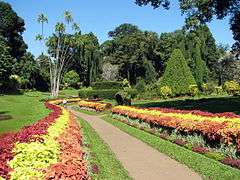Royal Botanical Gardens, Peradeniya
| Royal Botanic Gardens of Sri Lanka | |
|---|---|
 | |
| Type | Botanical garden |
| Location | Peradeniya, Sri Lanka |
| Coordinates | 7°16′16″N 80°35′44″E / 7.27111°N 80.59556°ECoordinates: 7°16′16″N 80°35′44″E / 7.27111°N 80.59556°E |
| Area | 147 acres (59 ha) |
| Created | around 1750 |
| Operated by | Department of National Botanic Gardens, Sri Lanka |
| Status | Open all year |
| Website | |
Royal Botanic Gardens, Peradeniya are about 5.5 km to the west of the city of Kandy in the Central Province of Sri Lanka. It attracts 2 million visitors annually.[1] It is near the Mahaweli River (the longest in Sri Lanka).[2] It is renowned for its collection of orchids. The garden includes more than 4000 species of plants, including orchids, spices, medicinal plants and palm trees.[1] Attached to it is the National Herbarium of Sri Lanka. The total area of the botanical garden is 147 acres (0.59 km2), at 460 meters above sea level, and with a 200-day annual rainfall. It is managed by the Division of National Botanic Gardens of the Department of Agriculture.
History
The origins of the Botanic Gardens date as far back as 1371 when King Wickramabahu III ascended the throne and kept court at Peradeniya near the Mahaweli river. This was followed by King Kirti Sri and King Rajadhi Rajasinghe. A temple was built on this location by King Wimala Dharma, but it was destroyed by the British when they were given control over the Kingdom of Kandy.
Thereafter, the groundwork for a botanical garden was formed by Alexandar Moon in 1821. He used the garden for coffee and cinnamon plants.[3] The Botanical Garden at Peradeniya was formally established in 1843 with plants brought from Kew Garden, Slave Island, Colombo, and the Kalutara Garden in Kalutara. The Royal Botanic Garden, Peradeniya was made more independent and expanded under George Gardner as superintendent in 1844. On Gardner's death in 1849 George Henry Kendrick Thwaites became superintendent. He served until he resigned in 1879, when he was succeeded by Henry Trimen, who served until 1895.[4][5]
The garden came under the administration of the Department of Agriculture when it was established in 1912.
There are avenues in the River Drive such as Cook's Pine Avenue, Palmyra Palm Avenue, Double Coconut Avenue, Cabbage Avenue, and Royal Palm Avenue.[6] The classical Avenue of Palms is in this Garden. One item with a significant history is the Cannonball Tree planted by King George V of the United Kingdom and Queen Mary in 1901. It is often laden with fruit, which are thought to resemble cannonballs.
During World War II, the Botanic Garden was used by Lord Louis Mountbatten, the supreme commander of the allied forces in the South Asia, as the headquarters of the South East Asia Command.
Other botanic gardens in Sri Lanka
- Hakgala Botanical Garden
- Henarathgoda Botanical Garden[7]7°06′00″N 79°59′10″E / 7.0999345°N 79.9860853°E
- Mirijjawila Botanical Garden
- Seetawaka Botanical Garden, Avissawella 6°57′11″N 80°13′06″E / 6.9531°N 80.2183°E
- Medicinal Plant Gardens, Ganewatta[8][9] near 7°39′25″N 80°22′09″E / 7.6568084°N 80.3692818°E
References
- 1 2 Royal Botanic Gardens Peradeniya Official Guide Map 2013
- ↑ "Peradeniya Botanical Garden".
- ↑ "PERADENIYA BOTANICAL GARDEN".
- ↑
 Boulger, George Simonds (1899). "Trimen, Henry". In Lee, Sidney. Dictionary of National Biography. 57. London: Smith, Elder & Co.
Boulger, George Simonds (1899). "Trimen, Henry". In Lee, Sidney. Dictionary of National Biography. 57. London: Smith, Elder & Co. - ↑ "Royal Society Biographical entry". Royal Society website. Retrieved 2012-09-28.
- ↑ "PERADENIYA BOTANICAL GARDEN".
- ↑ Archived index at the Wayback Machine.
- ↑ "Ganewatta – Offline". http://www.botanicgardens.gov.lk/. Retrieved 2013-10-18. External link in
|publisher=(help) - ↑ https://web.archive.org/web/20120426001649/http://pooranee.com/~botanicg/ganewatta/index.php?option=com_frontpage&Itemid=1. Archived from the original on April 26, 2012. Retrieved November 24, 2011. Missing or empty
|title=(help)
External links
| Wikimedia Commons has media related to Botanical Garden of Peradeniya. |
- Department of National Botanic Gardens
- Peradeniya Royal Botanical Gardens
- Peradeniya:
- Photo and video essay of the botanical garden
- Botanical Gardens, Zoo earn record income